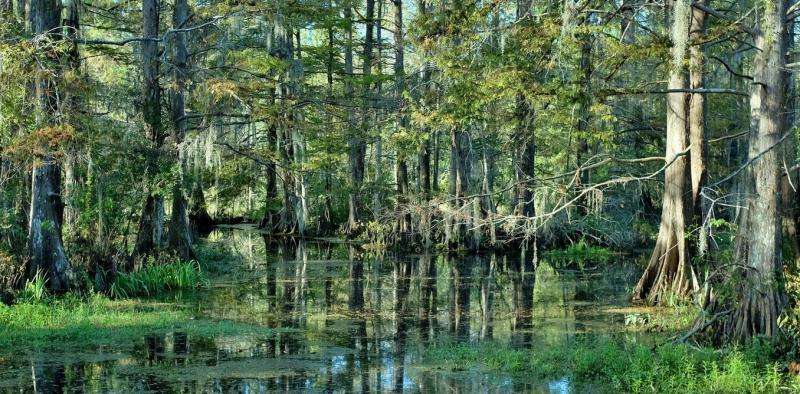To curb climate change, we need to protect and expand US forests

Forests have been removing carbon dioxide from the atmosphere and storing carbon for more than 300 million years. When we cut down or burn trees and disturb forest soils, we release that stored carbon to the atmosphere. Since the start of the Industrial Revolution, one-third of all carbon dioxide emissions to the atmosphere from human activities .
To slow climate change, we need to rapidly reduce global emissions from fossil fuels, biofuels, deforestation and wetland and agricultural soils. We need to also accelerate the removal of carbon dioxide that is already in the atmosphere.
In a published by the nonprofit Dogwood Alliance, my co-author and I show that we have a major opportunity to make progress on climate change by restoring degraded U.S. forests and soils. If we reduce logging and unsustainable uses of wood, we can increase the rate at which our forests remove carbon dioxide from the atmosphere and ensure that it will remain stored in healthy forests.
An undervalued resource
At the 2015 Paris climate conference, the United States and 196 other nations agreed to combat climate change by cutting their greenhouse gas emissions. The recognizes that forests play an important role in meeting climate goals by removing carbon dioxide from the atmosphere and storing carbon in trees and soils. But the agreement calls for steps only to protect and restore tropical forests.
These forests clearly are important. They hold such enormous amounts of carbon that if they were a country, their emissions from logging and forest clearing would rank them as , behind China and the United States.
But these activities are also having a serious and little-recognized impact in the United States. Net U.S. forest growth each year removes an amount of carbon dioxide from the atmosphere equal to . This is only about half of the average carbon uptake by forests worldwide. In other words, U.S. forests are much less effective at capturing and storing carbon relative to our fossil fuel emissions than forests globally.
The greatest contribution to this gap is logging. We are cutting trees in the United States at a rate that has . Recent satellite images show that the southeastern United States .
Overharvesting reduces carbon storage
When European settlers arrived at the start of the 17th century, forests covered much of the eastern and northern portion of North America. By the late 1800s, . Only of original intact old-growth forest remains in the lower 48 states. Regrowth now covers 62 percent of areas that originally were forested, and commercial tree plantations cover .
Tree plantations grow rapidly but are harvested frequently and retain very little soil carbon and are harvested more frequently. As a result, they .
And we are still logging our forests at a significant rate. According to recent studies, timber harvesting in U.S. forests currently than fossil fuel emissions from the residential and commercial sectors combined.
These harvests support a large wood and paper products industry. The United States produces about – more than any other country in the world. It is also the leading producer of wood pellets and wood chips for the growing forest bioenergy sector (burning wood in various forms for energy) at home and abroad.
Wood energy is not low-carbon
Forest bioenergy is widely considered to be a renewable fuel source, because new trees can grow – albeit slowly – to replace those that are consumed. But it is not a low-carbon energy source. . Burning wood in power plants to generate electricity is typically .
But proponents assert that forest bioenergy is carbon-neutral because new tree growth, somewhere now or in the future, removes carbon dioxide from the atmosphere and "offsets" carbon emissions when biofuels are burned. Although the Intergovernmental Panel on Climate Change has stated clearly that , the European Union and many U.S. states classify biomass as a zero-carbon energy source like wind and solar power.
Today 60 percent of the European Union's renewable energy comes from bioenergy. Notably, the United Kingdom is ending its use of coal for electricity, but is replacing coal with wood pellets imported from the southeast United States.
Needless to say, it does not make economic sense to import eight million tons of wood pellets yearly across the Atlantic Ocean. However, the British government has provided to utilities to pay the cost of pellet production and transport.
Moreover, under climate accounting rules, emissions from burning wood for energy are counted as coming from land use change—that is, harvesting trees. This means that the United Kingdom is outsourcing carbon emissions from its wood-fired power plants to the United States. And the U.S. forest products industry and U.K. power companies are profiting from activities that have serious harmful impacts on Earth's climate.
The value of standing forests
Forests provide more than forest products or carbon storage. They prevent flooding, provide , support wildlife, and provide a storehouse of .
To make forests part of our climate strategy, we need a carbon accounting system that accurately reflects flows of carbon between the biosphere and the atmosphere. Bioenergy emissions should be counted as coming from energy production, rather than as a land use change.
We also must manage our forest systems on a sound ecological basis rather than as an economic growth-oriented business, and value the multiple ecosystem services that forests provide. One way to do this would be to pay landowners for maintaining standing forests instead of only subsidizing logging for timber, fiber or fuel. We cannot log and burn our way to a low-carbon, stable climate future.
Provided by The Conversation
This article was originally published on . Read the .![]()



















